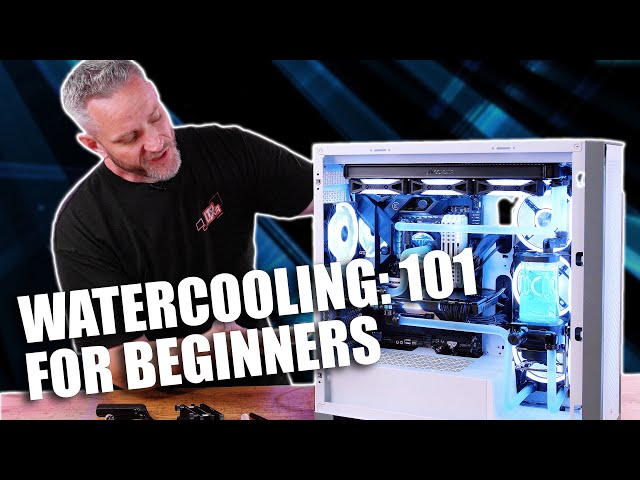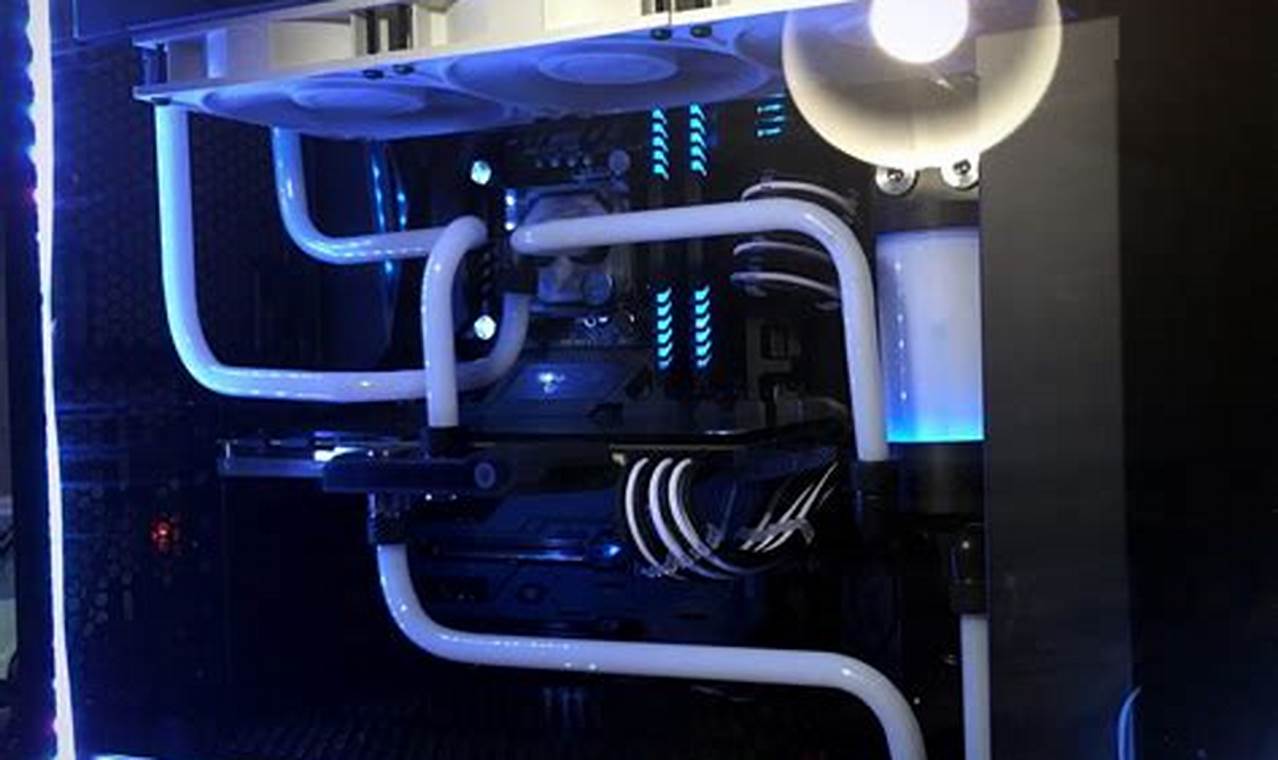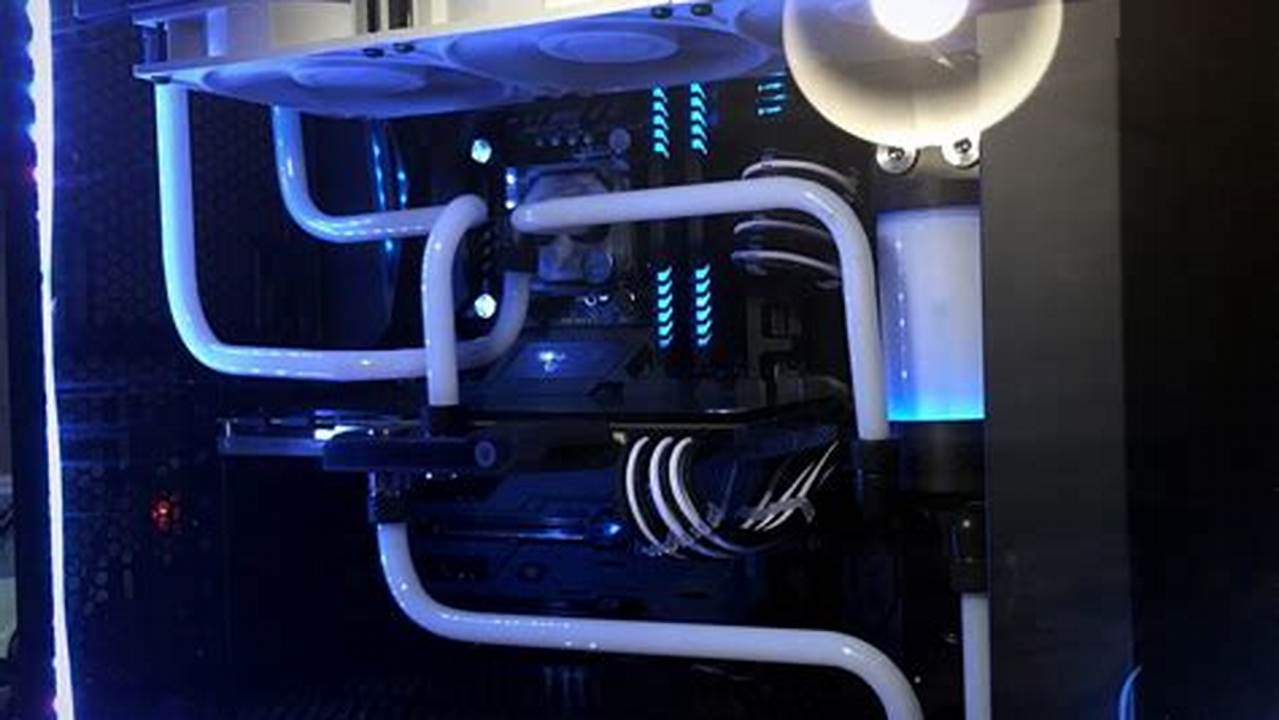A “guide to PC water cooling for beginners” is a comprehensive resource providing essential knowledge and practical instructions for those interested in exploring the world of water-cooled computers. Like a culinary guide that unravels the secrets of gourmet cooking, this guide unlocks the intricacies of PC water cooling, enabling enthusiasts to create high-performance, visually stunning systems.
The benefits of water cooling are undeniable: enhanced performance, reduced noise levels, and extended component longevity. Its historical roots can be traced to the early days of computing, where enthusiasts experimented with innovative cooling methods to push their systems to the limits. Today, water cooling has become an integral part of the PC gaming and overclocking communities.
This guide will delve into the fundamentals of PC water cooling, covering essential components, loop design, and maintenance. Whether you’re a seasoned builder or a novice seeking to upgrade your cooling setup, this resource will equip you with the knowledge and confidence to embark on your water-cooling journey.
Guide to PC Water Cooling for Beginners
Understanding the essential aspects of PC water cooling is crucial for beginners to create reliable, high-performance systems. These aspects encompass the foundation of water cooling and provide a roadmap for successful implementation.
- Components: Radiators, pumps, reservoirs, blocks, tubing
- Loop Design: Serial vs. parallel, flow direction, component placement
- Coolants: Types, properties, maintenance
- Installation: Tools, techniques, safety precautions
- Maintenance: Flushing, cleaning, leak detection
- Overclocking: Water cooling’s role in pushing system limits
- Aesthetics: Custom loops, RGB lighting, reservoir design
- Troubleshooting: Common problems and their solutions
These aspects are interconnected, influencing the overall performance, reliability, and aesthetics of a water-cooled PC. By understanding and carefully considering each aspect, beginners can build systems that meet their specific needs and exceed expectations. For instance, selecting the right components and designing an efficient loop layout can significantly improve cooling performance. Regular maintenance ensures system longevity and prevents potential leaks, while understanding overclocking principles allows enthusiasts to safely push their hardware to its limits.
Components
In the realm of PC water cooling, meticulously selecting and integrating essential components is paramount. These components, namely radiators, pumps, reservoirs, blocks, and tubing, form the backbone of any water-cooling system and directly influence its performance and reliability.
Radiators serve as the heat exchange interface between the water loop and the ambient air, dissipating heat generated by the system’s components. Pumps, the driving force of the loop, circulate the coolant throughout the system, ensuring efficient heat transfer. Reservoirs provide a buffer for the coolant, accommodating expansion and contraction during temperature fluctuations, and allowing for easy filling and bleeding of the loop.
Water blocks, precision-engineered to fit specific components, effectively transfer heat away from CPUs, GPUs, and other heat-generating components. Tubing, the circulatory network of the loop, connects all components, enabling the seamless flow of coolant. The choice of tubing material, diameter, and routing significantly impact flow dynamics and cooling performance.
Understanding the relationship between these components is crucial for beginners embarking on their water-cooling journey. Each component plays a vital role in maintaining optimal system temperatures, ensuring stability, and extending component longevity. By carefully selecting and integrating these components, enthusiasts can create bespoke water-cooling systems tailored to their specific needs and aesthetic preferences.
Loop Design
Loop design is a crucial aspect of PC water cooling, influencing cooling efficiency, component temperatures, and overall system stability. Understanding the intricacies of serial vs. parallel loop configurations, flow direction, and optimal component placement is essential for beginners embarking on their water-cooling journey.
- Serial vs. Parallel Loops: Serial loops connect components in a single, sequential path, while parallel loops split the coolant flow into multiple paths. Serial loops offer higher pressure and flow rates, but parallel loops provide better cooling capacity and redundancy.
- Flow Direction: The direction of coolant flow through components impacts cooling performance. Generally, it’s optimal to direct the flow from the hottest component (e.g., CPU) to the coolest component (e.g., radiator) to maximize heat transfer.
- Component Placement: The physical arrangement of components within the loop affects coolant flow and cooling efficiency. Positioning the radiator at the top of the case promotes natural convection, while placing the pump at the bottom of the loop ensures a positive suction head.
- Loop Order: The sequence in which components are connected in the loop can influence cooling performance and component temperatures. Placing high-heat-generating components, such as the CPU and GPU, closer to the radiator allows for more efficient heat dissipation.
Optimizing loop design requires careful consideration of these factors and striking a balance between cooling performance, component temperatures, and system stability. By understanding the principles and implications of loop design, beginners can create water-cooling systems that effectively manage heat, enhance performance, and ensure the longevity of their PC components.
Coolants
In the realm of PC water cooling, understanding the types, properties, and maintenance of coolants is essential for beginners embarking on their water-cooling journey. Coolants play a vital role in heat transfer and system performance, and choosing the right coolant and maintaining it properly can significantly impact cooling efficiency and longevity.
- Coolant Types: Various types of coolants are available, each with its own unique properties and applications. Common types include distilled water, pre-mixed coolants, and concentrated coolants. Beginners may opt for pre-mixed coolants for ease of use, while enthusiasts may prefer concentrated coolants for customization and performance.
- Coolant Properties: Coolants are characterized by their thermal conductivity, specific heat capacity, and viscosity. Thermal conductivity measures the ability to transfer heat, specific heat capacity determines the amount of heat absorbed per unit mass, and viscosity affects flow dynamics and pumping requirements.
- Coolant Maintenance: Regular maintenance is crucial to ensure optimal coolant performance and prevent system damage. This includes monitoring coolant levels, checking for leaks, and periodically flushing and replacing the coolant. Proper maintenance can extend the lifespan of the cooling system and prevent corrosion or other issues.
- Additives and Inhibitors: Coolants often contain additives and inhibitors to enhance their properties and protect system components. These additives can improve thermal conductivity, prevent corrosion, and inhibit microbial growth. Understanding the purpose and compatibility of additives is essential for effective coolant maintenance.
By comprehending the types, properties, and maintenance requirements of coolants, beginners can make informed decisions regarding their water-cooling systems. Proper coolant selection and maintenance practices contribute to efficient heat transfer, system stability, and extended component life, ensuring a seamless and enjoyable water-cooling experience.
Installation
In the realm of PC water cooling, proper installation is paramount to ensure a leak-free, efficient, and safe system. A comprehensive “guide to PC water cooling for beginners” must include detailed instructions and safety considerations for installing the various components.
The choice of tools and techniques significantly impacts the success and safety of the installation process. Beginners should familiarize themselves with essential tools, such as tubing cutters, compression fittings, and torque wrenches, and master the proper techniques for cutting, bending, and securing tubing. Neglecting these aspects can lead to leaks, reduced cooling performance, or even component damage.
Safety precautions are of utmost importance when working with water-cooling systems. Beginners must understand the potential hazards of electrical components, sharp edges, and hot liquids. Proper grounding, wearing appropriate safety gear, and following established guidelines are crucial to prevent injury or damage to the system. Overlooking safety measures can have severe consequences, ranging from minor inconveniences to catastrophic failures.
In summary, understanding and adhering to proper installation techniques and safety precautions are indispensable aspects of a “guide to PC water cooling for beginners.” By addressing these details, beginners can confidently embark on their water-cooling journey, minimizing risks and maximizing the benefits of this advanced cooling method.
Maintenance
Within the realm of PC water cooling for beginners, maintenance plays a pivotal role in ensuring system longevity, stability, and optimal performance. Regular flushing, cleaning, and leak detection are crucial elements of a comprehensive maintenance routine, directly contributing to the overall effectiveness of the water-cooling system.
Neglecting proper maintenance can lead to a myriad of issues, including reduced cooling performance, component damage, and even system failure. Sediments, particulate matter, and corrosion can accumulate within the loop over time, obstructing coolant flow and diminishing heat transfer efficiency. Regular flushing and cleaning remove these contaminants, restoring optimal flow and cooling capabilities.
Leak detection is another critical aspect of maintenance, allowing for early identification and resolution of potential leaks that could otherwise cause catastrophic damage to the system. By employing regular visual inspections, pressure testing, and monitoring for leaks using sensors or dyes, beginners can proactively address any issues, preventing further complications and ensuring system integrity.
Understanding the interconnections between maintenance, system performance, and component longevity is paramount for beginners embarking on their water-cooling journey. By adhering to a diligent maintenance schedule, beginners can reap the benefits of a well-maintained water-cooling system, including enhanced cooling performance, extended component lifespan, and peace of mind.
Overclocking
Within the realm of PC water cooling, overclocking stands as a tantalizing prospect for enthusiasts seeking to extract maximum performance from their systems. However, harnessing the full potential of overclocking demands an efficient cooling solution, and water cooling emerges as the champion in this domain.
- Increased Thermal Headroom: Water cooling’s superior heat dissipation capabilities provide a greater thermal headroom, allowing components to operate at higher clock speeds while maintaining stable temperatures.
- Precise Temperature Control: Unlike air cooling, water cooling offers more granular temperature control, enabling enthusiasts to fine-tune system performance and push overclocking limits.
- Enhanced Stability: The consistent and uniform cooling provided by water cooling minimizes thermal fluctuations, leading to improved system stability, especially during demanding overclocking scenarios.
- Aesthetic Appeal: Custom water-cooling loops not only enhance cooling capabilities but also add a touch of visual flair to the system, showcasing the enthusiast’s dedication to performance and aesthetics.
These factors collectively demonstrate the crucial role of water cooling in unlocking the full potential of overclocking. By providing superior cooling performance, precise temperature control, and enhanced stability, water cooling empowers enthusiasts to push their systems to the limits and achieve unprecedented levels of performance.
Aesthetics
Within the realm of PC water cooling for beginners, aesthetics play a significant role, extending beyond mere visual appeal to encompass functionality and customization. Custom water-cooling loops, adorned with RGB lighting and intricately designed reservoirs, serve as testaments to the creativity and dedication of enthusiasts.
The intricate designs of custom loops not only enhance the visual appeal of a system but also contribute to its cooling efficiency. By meticulously planning the layout of the loop, enthusiasts can optimize coolant flow and minimize restrictions, resulting in improved heat dissipation.
RGB lighting adds a dynamic element to water-cooling systems, allowing enthusiasts to personalize their builds with a spectrum of colors and effects. Beyond aesthetics, RGB lighting can provide valuable diagnostic information, as changes in lighting patterns can indicate potential issues within the loop.
Reservoirs, often overlooked as purely functional components, have evolved into canvases for artistic expression. Custom reservoirs, featuring unique shapes, materials, and integrated lighting, transform the reservoir into a focal point of the system, showcasing the creativity and attention to detail of the builder.
The interplay between aesthetics and functionality in PC water cooling for beginners is undeniable. By embracing the artistic potential of custom loops, RGB lighting, and reservoir design, beginners can create water-cooling systems that not only perform exceptionally but also reflect their personal style and dedication to the craft.
Troubleshooting
In the realm of PC water cooling for beginners, troubleshooting plays a critical role in resolving common issues and maintaining optimal system performance. Understanding potential problems and their solutions empowers beginners to diagnose and address these issues effectively.
- Leak Detection and Prevention: Leaks are a major concern in water-cooling systems. Identifying potential leak points, employing proper sealing techniques, and performing regular inspections can help prevent leaks and protect components from damage.
- Flow Rate Issues: Insufficient or excessive flow rate can impact cooling efficiency. Troubleshooting involves checking pump performance, ensuring proper loop design, and eliminating flow restrictions to optimize flow rate.
- Temperature Monitoring and Control: Monitoring water temperature is essential to ensure effective cooling. Using software or hardware sensors, beginners can track temperatures and adjust fan speeds or pump settings to maintain optimal thermal conditions.
- Noise Reduction: Water-cooling systems can generate noise from pumps, fans, or vibrations. Troubleshooting involves identifying the source of noise, implementing vibration dampeners, and adjusting pump speeds to minimize noise levels.
By understanding and addressing these common problems, beginners can ensure the reliability and longevity of their water-cooling systems. Troubleshooting empowers them to proactively maintain their systems, prevent potential issues, and enjoy the benefits of efficient and aesthetically pleasing water cooling.
Frequently Asked Questions about PC Water Cooling for Beginners
This FAQ section provides concise answers to common queries and clarifies essential aspects of PC water cooling for beginners. These questions anticipate potential concerns and aim to enhance understanding and confidence in this cooling method.
Question 1: Is water cooling difficult for beginners?
Answer: With careful planning and adherence to instructions, water cooling is accessible to beginners. It requires some technical knowledge and attention to detail, but the benefits often outweigh the challenges.
Question 2: What are the advantages of water cooling over air cooling?
Answer: Water cooling offers superior cooling performance, quieter operation, and the potential for overclocking. It also allows for more flexibility in component placement and system aesthetics.
Question 3: What is the best type of water-cooling system for beginners?
Answer: Closed-loop water-cooling systems are recommended for beginners due to their ease of installation, maintenance, and reliability. They come pre-filled and sealed, minimizing the risk of leaks.
Question 4: How often should I maintain my water-cooling system?
Answer: Regular maintenance is crucial. This includes checking for leaks, monitoring coolant levels and temperatures, and cleaning or replacing the coolant and components as needed.
Question 5: Can I use any type of liquid for water cooling?
Answer: Distilled water is the recommended coolant due to its high heat capacity and low electrical conductivity. However, pre-mixed coolants or concentrated coolants with additives can offer enhanced performance and protection.
Question 6: What are some common troubleshooting tips for water-cooling systems?
Answer: If you encounter issues such as leaks, high temperatures, or noise, check for loose connections, air bubbles in the loop, or pump failure. Addressing these issues promptly can help maintain optimal system performance.
These FAQs provide a foundation for beginners to confidently explore PC water cooling. Understanding these aspects will empower them to make informed decisions and enjoy the benefits of this advanced cooling method.
In the next section, we will delve into advanced topics and considerations, including custom water-cooling loops, overclocking using water cooling, and aesthetics in water-cooling systems.
Tips for Beginners
Embarking on your water-cooling journey requires careful planning and attention to detail. These practical tips will guide you through essential considerations, empowering you to create an efficient and reliable water-cooling system for your PC.
Tip 1: Plan Your Loop Carefully: Sketch out your loop design, considering component placement, tubing length, and radiator size. This will ensure a well-optimized and aesthetically pleasing loop.
Tip 2: Choose the Right Components: Select high-quality components that are compatible with your system and cooling needs. Invest in a reliable pump, durable tubing, and an efficient radiator to maximize cooling performance.
Tip 3: Prepare Your System: Before installing your water-cooling system, clean your components and ensure proper airflow within your PC case. This will prevent contamination and promote optimal cooling.
Tip 4: Install with Precision: Follow the manufacturer’s instructions carefully during installation. Secure all fittings and connections tightly to prevent leaks. Use a torque wrench to ensure proper tightening.
Tip 5: Bleed the System Thoroughly: Eliminate air bubbles by tilting and rotating your case. Use a fill port or bleed valve to release trapped air, ensuring optimal coolant flow and cooling efficiency.
Tip 6: Monitor Regularly: Keep an eye on your system’s temperatures and coolant levels. Use software or hardware monitoring tools to detect any abnormalities and address them promptly.
Tip 7: Perform Regular Maintenance: Water-cooling systems require periodic maintenance. Clean the components, replace the coolant, and check for leaks regularly to maintain optimal performance and prevent issues.
Tip 8: Enjoy the Benefits: With a properly installed and maintained water-cooling system, you can experience the benefits of lower temperatures, quieter operation, and enhanced overclocking potential for your PC.
By following these tips, you can confidently navigate the world of PC water cooling and reap its numerous advantages. In the next section, we will explore advanced topics and delve deeper into the intricacies of custom water-cooling loops, overclocking, and aesthetics.
Conclusion
This comprehensive guide has delved into the intricacies of “PC water cooling for beginners,” providing a roadmap for enthusiasts to confidently navigate this advanced cooling method. We explored the essential components, design principles, maintenance techniques, and troubleshooting strategies, empowering beginners to create efficient, reliable, and aesthetically pleasing water-cooling systems.
Key takeaways include the importance of selecting high-quality components, optimizing loop design for effective heat transfer, and performing regular maintenance to ensure system longevity. Additionally, we emphasized the role of water cooling in enabling overclocking and enhancing system performance while maintaining stability. By understanding these concepts and applying the practical tips provided, beginners can harness the benefits of water cooling and elevate their PC gaming and enthusiast experiences.


